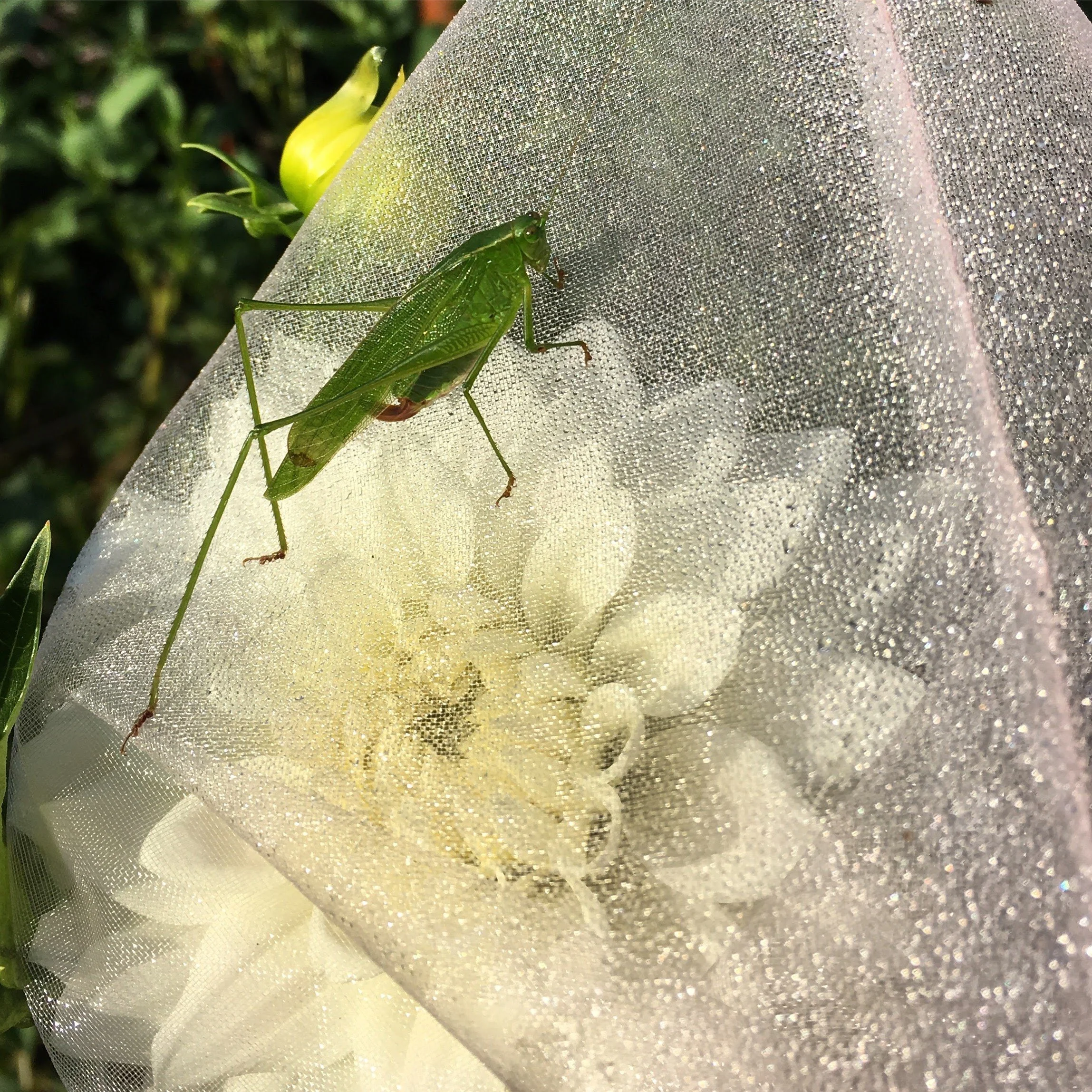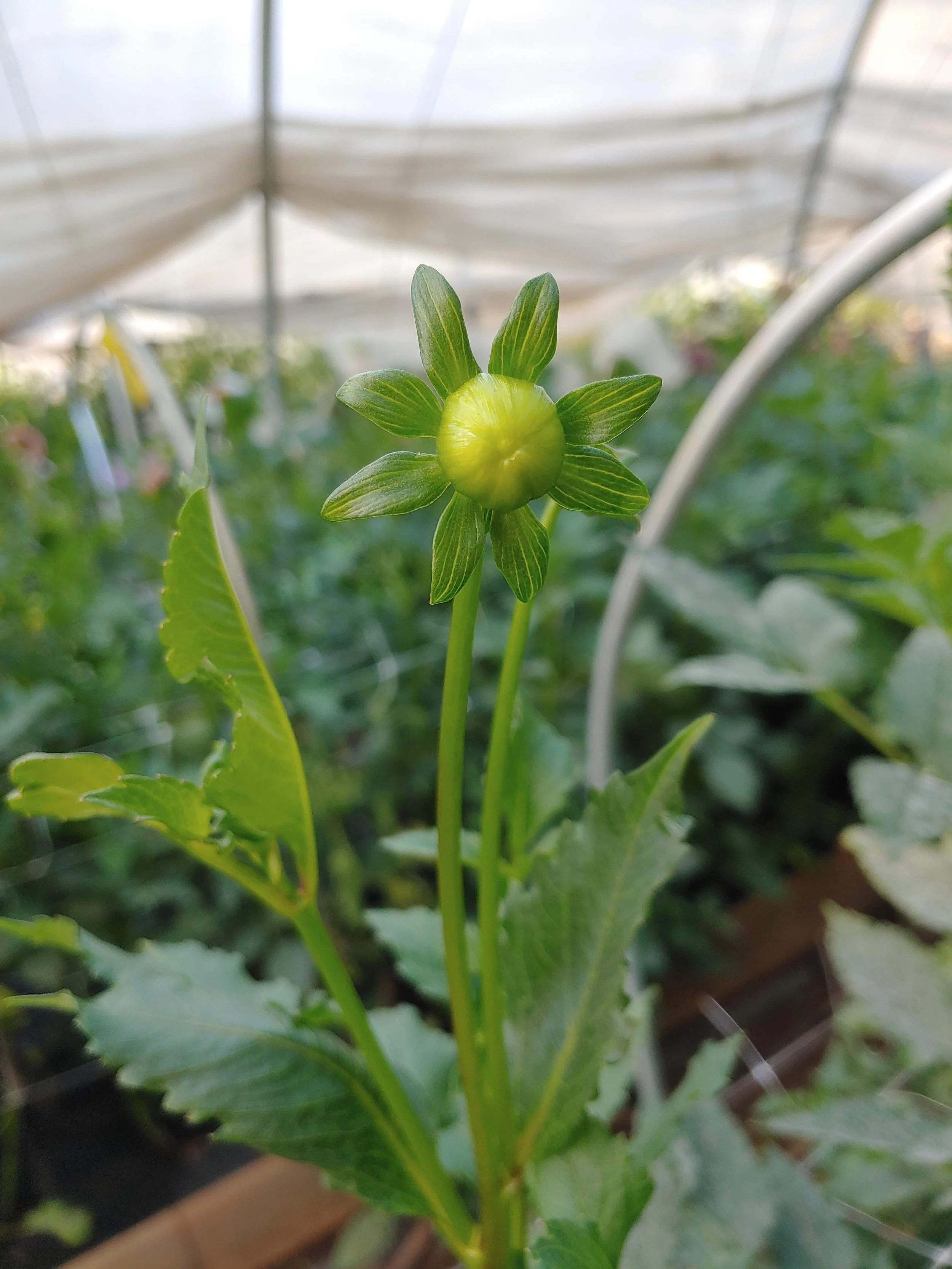What's Eating My Dahlias- Part 2
Dahlias are gorgeous! Unfortunately all the bugs think so too. Let’s talk about how to deal with some of the most common pests: grasshoppers, thrips, tarnished plant bug (TPB), cucumber beetles, and leafhoppers. These methods work well for the home gardener and small scale grower. I use organic pest control methods. There are plenty of other options out there but I choose organic on our farm so that’s what you’ll find covered here.
Let’s start with the most full proof pest control method: Prevent the pest from even touching your dahlia. This is accomplished by the use of organza bags— you know the kind they use for wedding favors.
These work extremely well for a cut flower operation or cut flower specific garden. They block everything from getting your blooms. However if you are enjoying your dahlias in a backyard garden style setting, you may not want to look at “dahlia lollipops” all the time. Kinda’ diminishes the joy of it.
Grasshoppers are the hardest to control in my opinion. There aren’t many organic sprays that will touch a hard bodied insect. The best control for a grasshopper that I’ve found is attracting birds to your garden. Birds love to eat grasshoppers. Adding a water source, even a small one, is a great way to attract birds.
If you have chickens, even better- they will devour them. Just make sure your plants are big enough to take a little chicken abuse. Usually grasshoppers don’t become a menace until the plants are blooming so at that point, allowing chickens into your dahlia patch can work. I used to use this method a lot until a fox got all our chickens.
Botanigarde Maxx is the only spray I’ve ever encountered that will kill a grasshopper and even it’s hit or miss— Grasshoppers move quickly so it’s hard to get the spray on them. If grasshoppers are a serious issue for you, consideration of the organza bag will have to be done. It’s the most effective method for grasshopper control.
Thrips are an annoying nemesis when it comes to dahlias. Timing is one of the best methods I’ve found for dealing with them. In my climate, thrips are a bad issue from mid- May to mid summer. Then they die back and aren’t found in high infestation level numbers. Thrips are probably the number one reason I don’t grow early season dahlias. Organza bags are reasonably effective against them but thrips are so small that they can get inside the bags sometimes. Various sprays will work on them and keep the populations under control but having perfect light colored dahlias is a challenge during thrip season. If you need dahlias during thrip season, stick with brighter colors- thrips are more attracted to whites/light colors.
A pyrethrin spray or a spinosad spray is a pretty effective tool against thrips. I highly recommend alternating what you spray. Also one round of spraying won’t cut it, it’s something you have to do regularly during the pest’s season.
Tarnished Plant Bugs and Leafhoppers - these 2 can be controlled by the same method. The yellow sticky trap is my best friend. Now— don’t freak out. I know, I know- small animals (birds, lizards, etc) can get caught on these and die. However, I’ve learned you can still use them but you gotta get crafty in how you hang them.
A yellow sticky trap is a card coated with a sticky substance that attracts particular pests. It’s great at catching small flying insects. You want to keep the card size to no larger than 3x5. I punch a hole in mine and hang them below my netting so that they are in the main plant canopy. Keeping it down in the plant canopy is key so that it’s less likely to be in a bird’s flight path. Also, I’ve learned you want to make sure the card can swing. This keeps lizards off of them. If you fasten it tightly so it’s immobile, baby lizards will crawl on it and not be able to get off.
Leafhoppers are important to control and they are often overlooked because they don’t show physical damage to your plant quickly. They do chew on the plant but it’s not super noticeable. However, they are vector insects- meaning they can take a virus from one plant to another. And in this day and age, when dahlia viruses are becoming more common, controlling leafhoppers will help protect your dahlia plant stock.
Cucumber beetles- other than grasshoppers, these are probably the most destructive of dahlia pests. They can chew a bloom incredibly fast. If you begin to see them in your field/garden, you want to act quickly because this is a pest you don’t want getting out of hand.
Once again, organza bags are the most effective method. But a spinosad or pyrethrin spray will work too.
One of the best things I did several years ago was to stop growing plants in the amaranth and squash plant families near my dahlias. Amaranth is a magnet for cucumber beetles. So much so that I’ve completely cut it from my crop list. If you can’t do that, move it as far from your dahlias as possible. I do still grow small quantities of squash and cucumbers in my veggie garden, but I have it as far from the flower field as I can go (and still be on my property).
So to sum it up- if you want a flawless dahlia, put an organza bag on it before the bud begins to open (in the green stage as shown in the picture above). If that option doesn’t appeal to you, then sprays and strategic plant placement are your best options. Also employ the sticky trap. Not only does the trap catch a lot of pests, but it’s pretty non-harming to you and others.



